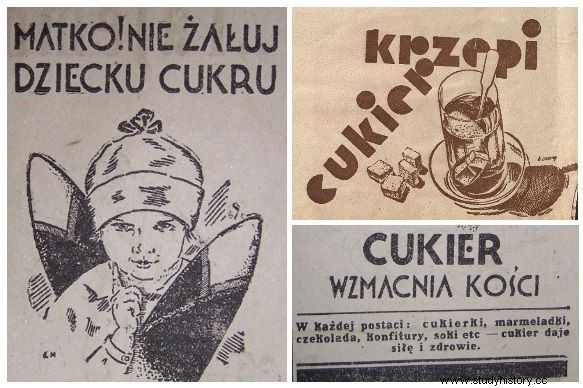Undoubtedly, the most famous advertising slogan of interwar Poland was the slogan invented by Melchior Wańkowicz:Sugar strengthens. Along with sugar in the Second Polish Republic, there were still some problems.
The war-devastated agriculture and sugar industry were initially unable to supply the market with a sufficient quantity of sweet goods. In August 1922, the "Illustrated Daily Kuryer" described how the Homeric struggle between speculators and consumers over the price of sugar was going on in Warsaw for the whole week. The diary reported [modernized spelling]:
At first the strippers completely hid the sugar, then started to release it a bit from their hiding places, but at the same time increased the price. This caused public outrage, followed by vigorous action by the press, and finally the authorities entered and the golden times of sugar strips are over.
A search was carried out here and there, the supplies were found, they were confiscated, the strippers were brought to the court and the sugar was found and the price remained old and normal, ie 650 marks per kilo. At us [in Krakow - the author's footnote] the same story plays out:you can't get sugar, or you have to pay more - in some stores up to 850 marks per cube .

Due to the high prices of sugar, it was necessary to conduct a wide advertising campaign. We owe her the most famous Polish advertising slogan of the interwar period, and perhaps of the entire century. We all know that sugar strengthens.
Polish sugar is not for the average Kowalski
Over time, the provisioning situation improved, but the prices for the average Kowalski were still exorbitant. This was because the sugar was subject to excise duties and it was by no means a symbolic fee. For every 100 kilograms, the manufacturer or importer had to pay as much as PLN 37 to the budget. The proceeds from this were considerable.
In the budget year 1935/36 alone, they amounted to PLN 122 million (which is more than the budget spent on road construction and maintenance at that time). As a curiosity, it can be added that in the interwar period, the sale of so-called sweeteners (saccharin, dulcine, etc.) took place only with the consent of the tax authorities. In addition, they could only be used for therapeutic (diabetic) or scientific purposes.
The effect of such a policy was that in 1928 in Warsaw a kilogram of sugar cost as much as 1.56 zlotys. In conversion, this price corresponded to about 15 zloty today! In other cities it was not much cheaper, and sometimes even more expensive, such as in Vilnius or Lviv, where you had to pay two groszy more.
For comparison, at the same time, a lonely high school teacher (not having three years of work) earned PLN 301 per month. As it is easy to count, such a schoolboy could buy about 200 kilograms of sugar for his salary, currently the trainee teacher is able to buy over 610 kilograms for his monthly wages. This gives food for thought, especially since the pre-war educators were really well rewarded for their work.
For Smith, absolutely
Even the outbreak of the Great Depression did not cause a significant drop in prices. In 1930, the average price per kilogram was 1.41 zlotys, and the same sugar was sold to Great Britain (calculated) for 17 groszy.
This was due to the use of dumping prices by the Polish government, which were to help improve the foreign trade balance. The cartelized sugar industry was recovering export losses on the domestic consumer, pushing up domestic prices.

Sugar ads could be found in almost every edition of dailies, weeklies and monthlies. Above are some examples of the pre-war school of advertising.
In the second half of the 1930s, the price dropped to around PLN 1 per kilogram, but due to the impoverishment of society sugar was still considered an almost luxurious commodity that could only be afforded by wealthier citizens.
***
Summing up, it is difficult to deny Wańkowicz is right. Sugar actually strengthens, but a large group of citizens of pre-war Poland did not have the opportunity to find out about it on a daily basis. Remember this when you hear about expensive sugar again.
Bibliography:
- 27 gr. a day to support a child in the countryside, Dziennik Poranny, May 15, 1938, No. 111, p. 1.
- Concise Statistical Yearbook 1938.
- M. Arcta Modern illustrated encyclopedia , Warsaw [1937].
- Tame the sugar bars! , "Ilustrowany Kuryer Codzienny", August 14, 1922, no. 218, p. 6.
- Teachers' salaries are rising faster than the national average , "Money.pl", September 1, 2010.
- Yearbook of statistics of the Republic of Poland , 1929.
- Jerzy Tomaszewski, Zbigniew Landau, Poland in Europe and the World 1918-1939 , Warsaw 2005.
